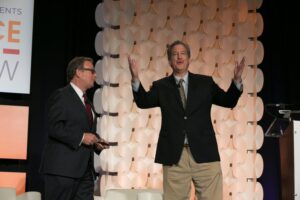
Members of 56 regional STEM Learning Ecosystems across North America gathered in Washington DC in early April to share ideas and programs for education in science, technology, engineering, and math (STEM). At the convening, members of the Ecosystems were able to exchange ideas from partners in their own areas as well as similar Ecosystems from across the country. Leaders from the Initiative presented their experiences at the adjacent U.S. News STEM Solutions Conference. The focus was on ensuring that education is developing the Workforce of Tomorrow.
Following are key takeaways from attendees with a wide range of backgrounds and ages:
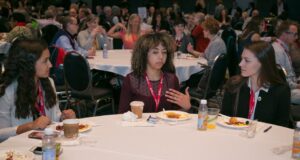
The Chief Science Officer (CSO) program is a leadership development program for middle and high school students who are interested in STEM studies. CSOs from several states attended (and presented at!) the conference. Everyone complimented the maturity and engagement of the youth who attended, and many people sought out the students for their perspectives on ideas and programs. High school student CSO Marissa was thrilled to have the chance to network with STEM organizations and businesses nationwide. She said, “It was very exciting to have so many adults there wanting to know my perspective on key STEM topics and initiatives.”
CSO Hayden said, “As a student, I learned just how invested people from all backgrounds are in STEM education. I spoke with educators from around the country who were seeking to improve their student involvement in STEM programs, and I spoke with businesses who were interested in providing opportunities for educators and students alike. I was really touched by the amount of passion each person at the Ecosystem had for STEM education, and I was able to connect with these individuals by putting a face to the future of STEM.” Learn more about the CSO experience here.
Watch this one-minute video for an overview of several key elements of the conference:
Eric Meyer is Assistant Director of Education at the Fleet Science Center and part of the San Diego Ecosystem. He appreciated the combination of the U.S. News STEM Solutions Conference with the STEM Ecosystem Community of Practice because it gave the opportunity to hear about initiatives that are working in specific locations and the ability to think about how those concepts could be applied more broadly and systemically. “The earn and learn models were particularly interesting as companies identified the need to invest in apprentice schools and community colleges to train their own workforce,” he said. Learn other takeaways about the workforce impact of education from Eric, as well as his desire to leverage STEM education to develop more global citizens.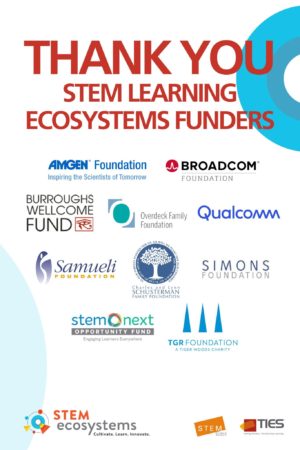
Several sessions centered on the power of partnerships and the value of the STEM Learning Ecosystems framework. Natasha Smith-Walker, Project Exploration, Chicago STEM Pathways Cooperative, said, “The evolution of public-private-corporate collaborations is necessary to build effective bridges between students, parents, educators and employers. High quality STEM learning opportunities must go beyond traditional classroom settings.”
Smith-Walker shared examples from Chicago, such as a Career Pathways partnership with Apple. Over the summer, schools and community-based organizations will host Apple Coding clubs to spark interest in technology. Pre-Professional Internships will be offered, where employees will mentor a small group of aspiring coders through project-based activities. For other examples of partnerships to benefit education, and to learn more about Smith-Walker’s professional path as a minority woman in STEM education, read this.
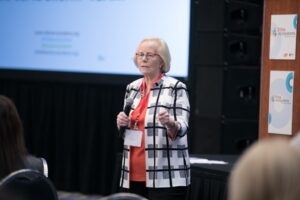
Debbi Stone, Vice President of Education at The Florida Aquarium, is a member of the Tampa Bay STEM Network. She found a common thread between several sessions: Rather than operating in a silo and determining what to “do TO our audience(s),” the most effective and purposeful work is a collaboration working WITH those we strive to serve. She said, “Too often, the audiences we’re trying our well-intentioned best to impact are absent from the conversation or brought in late, almost as an after-thought, when much of the high-level decision-making has already happened.” Read an example of this, plus get to know Debbi and her roundabout path from earning a Bachelor of Music in Saxophone Performance, to a part-time job at Mystic Aquarium that led her to love informal science and education.
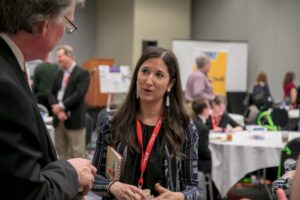
Also in conjunction with the national Community of Practice meeting, the inaugural Cohort of 21 LEAD STEM Fellows from across 19 STEM Learning Ecosystems came together for their third in-person meeting. These leaders had focused time to solicit feedback and refine their capstone projects which focus on specific elements of STEM education in their local communities. They also learned from experts in DC about the role of Federal partners and politicians in education policy, and they had the opportunity to refine their presentation skills, as well as meet with funders to learn how to best seek support. Learn more about LEAD STEM here.
Meeting attendees took to Twitter to share their thoughts on various sessions. Scroll through a compilation of the topical tweets below:
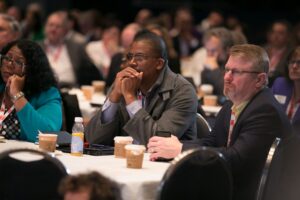
The STEM Learning Ecosystems structure creates strong, ongoing connections between participating communities and individuals. Conference attendees not only learned applicable principles and program details, they have continuing support from other Ecosystems as they work to implement new ideas and improve existing plans. This ongoing connection and collaboration is one of the many benefits of being an Ecosystem member. Learn more about the Ecosystems and the selection process. STEM Learning Ecosystems partnerships within communities and across the country are focused on offering students the best and most applicable STEM education in order to impact their careers and their lives. Join the Movement!
Members of STEM Learning Ecosystems that have a login to the password-protected Community of Practice website can access all of the slide decks from the conference here.
